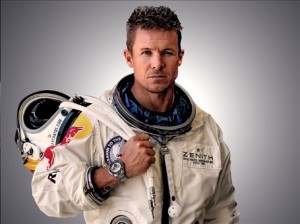Felix Baumgartner flying faster than the speed of sound
Felix Baumgartner, an Austrian daredevil, said that “20 tons have fallen from my shoulders” after becoming the first man to break the sound barrier.
“I think 20 tons have fallen from my shoulders. I prepared for this for seven years” – he told German-language ServusTV in Austria in his first interview after the leap.
Referring to a helmet problem that nearly forced him to abort at the last minute, Baumgartner said – “Even on a day like this when you start so well, then there’s a little glitch. But I finally decided to jump.
“It was the right decision” – added the Austrian, who broke three records: the highest freefall jump, the fastest freefall speed and the highest balloon flight by a human. He failed to make the longest freefall jump.
Felix Baumgartner stood alone at the edge of space, poised in the open doorway of a capsule suspended above Earth and wondering if he would make it back alive. Twenty four miles below him, millions of people were right there with him, watching on the Internet and marvelling at the wonder of the moment.
A second later, he stepped off the capsule and barrelled toward the New Mexico desert as a tiny white speck against a darkly-tinted sky. Millions watched him breathlessly as he shattered the sound barrier and then landed safely about nine minutes later, becoming the world’s first supersonic skydiver.
“When I was standing there on top of the world, you become so humble, you do not think about breaking records anymore, you do not think about gaining scientific data” – Mr Baumgartner said after the jump. “The only thing you want is to come back alive.”
The tightly-orchestrated jump meant primarily to entertain became much more than that in the dizzying, breathtaking moment – a collectively shared cross between Neil Armstrong’s moon landing and Evel Knievel’s famed motorcycle jumps on ABC’s “Wide World of Sports.”
The Austrian skydiver appeared anxious but in control throughout the mission, but his family could barely watch, covering their faces with their hands.
After two aborted attempts last week due to high winds that blew over the fragile balloon that was to lift Baumgartner, the mission finally set off after several delays on Sunday.
On his ascent, Baumgartner appeared to suffer a heating problem in the visor of the ultra-advanced spacesuit he wore for the attempt. The suit provided oxygen, which is scarce at such high altitudes, and prevented Baumgartner freezing on the way down. The problem was later resolved, and the balloon rose to the designated height above Roswell, New Mexico.
As he opened the gate of the capsule, Baumgartner unbuckled himself slowly and stared into the curvature of the Earth.
He then jumped without hesitation.
Baumgartner dropped at ever-faster speeds through the low-friction stratosphere, before at one point losing control and beginning to spin. At this point (he says) he had to make a very hard decision.
“There was a period of time where I really thought that I am in trouble” – Baumgartner told a press conference after the landing. “Because I have a manual push button where I can release a drogue shute which pulls me out of the flat spin. But at the same time I knew if I pushed this button – this thing is all over, we are not going to fly supersonic.”
